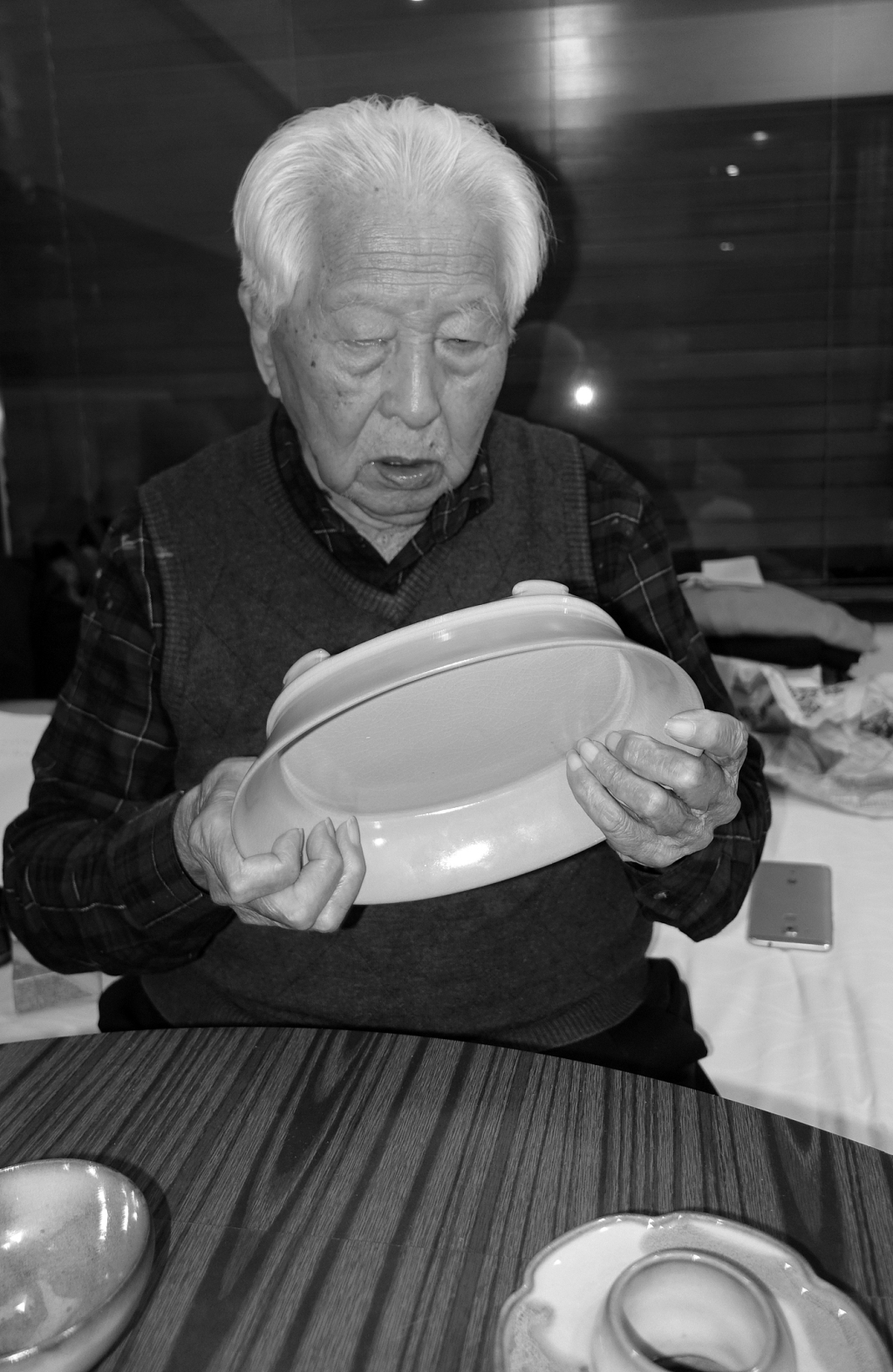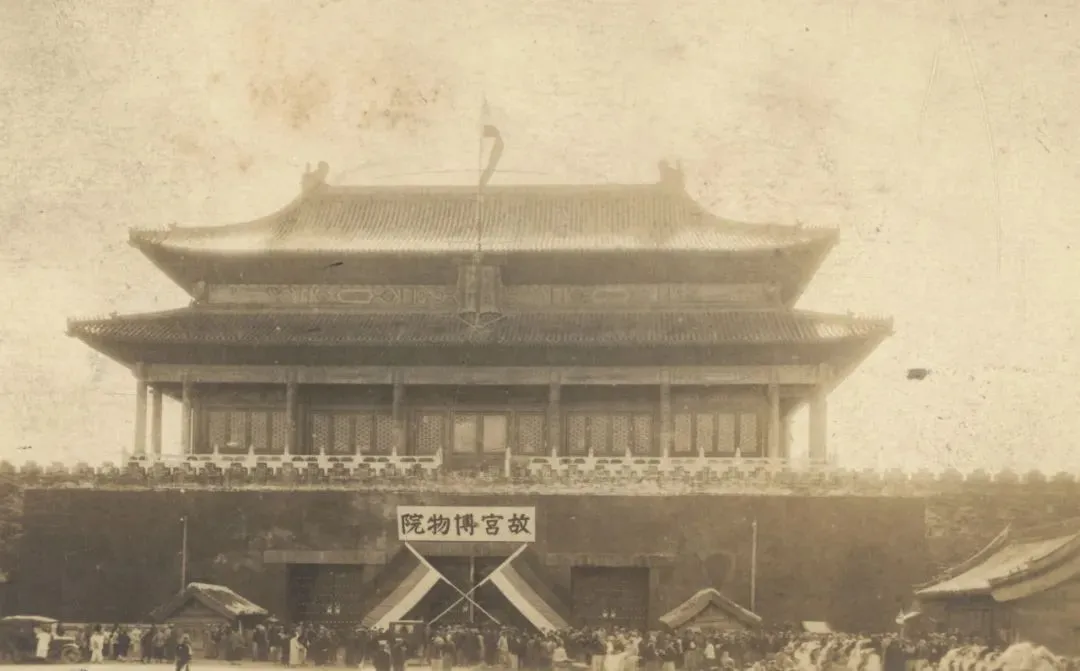
Around the Spring Festival, daffodils bloom, filling the water, like a fairy in the water, fluttering in the waves. Huang Tingjian's poem in the Northern Song Dynasty has "getting the water can make the heavens and wonders, and the cold fragrance and loneliness can move the ice muscles. Who is the fairy wind and bone today, and sweep the moth eyebrow hairpin lightly." "Crown Bai Yuying" comes to praise the product of Narcissus.
Narcissus is one of the traditional famous flowers in our country, and it is also the subject of frequent paintings by famous masters of all dynasties. Whether it is the long scroll of "Narcissus" written by Zhao Mengjian in the Song Dynasty, or the Narcissus written by Qiu Ying and Chen Chun in the Ming Dynasty, and Yun Shouping in the Qing Dynasty, all of them are exquisitely written, elegant and fragrant. On the occasion of the Chinese New Year, the "Forbidden City Flower Letter" of "Paper News·Ancient Art" specially sorts out the narcissus in the famous paintings collected by the National Palace Museum and the National Palace Museum in Taipei.
Song Narcissus picture page
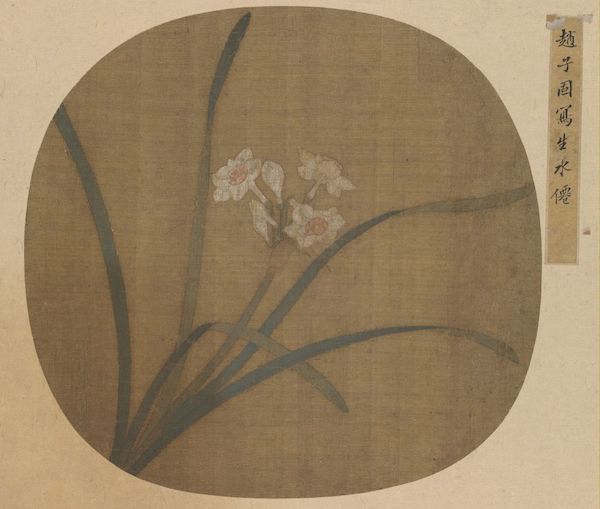
Song Narcissus Picture Page Collection of the Palace Museum
There is no stamp on this page. Mounted side old inscription: "Zhao Zigu's sketch of Narcissus".
In the picture, the daffodils are blooming, fresh and pleasant, the leaves are stretched but not messy, elegant and unrestrained, and the picture is divided into five parts, and the stamens are in the upper center, which is eye-catching. The petals are outlined with a fine brush, then dyed with white powder, and the stamens are dotted with orange, the color is elegant and elegant. This picture is concise and full of charm.
Song Zhao Mengjian Narcissus Roll
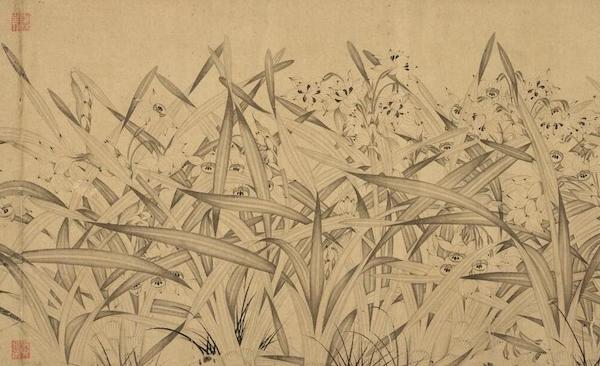
Narcissus scroll of Zhao Mengjian in Song Dynasty (partial) Collection of National Palace Museum, Taipei
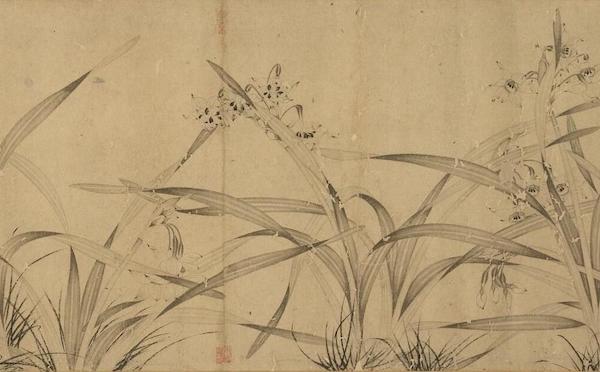
Narcissus scroll of Zhao Mengjian in Song Dynasty (partial) Collection of National Palace Museum, Taipei
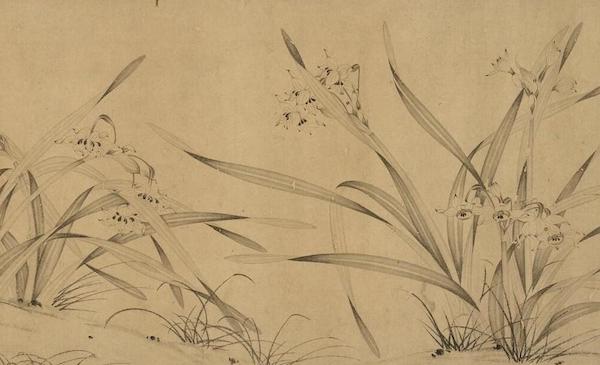
Narcissus scroll of Zhao Mengjian in Song Dynasty (partial) Collection of National Palace Museum, Taipei
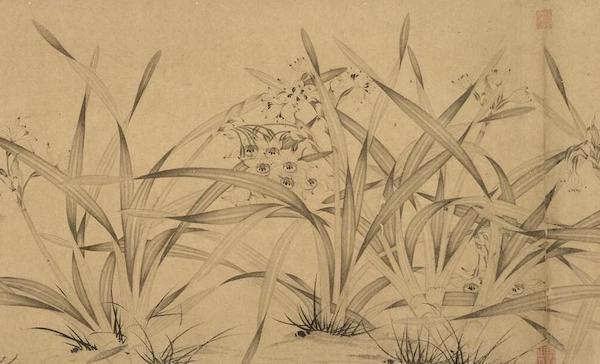
Narcissus scroll of Zhao Mengjian in Song Dynasty (partial) Collection of National Palace Museum, Taipei
Zhao Mengjian (1199-1264), styled Zigu, was the imperial family of Song Dynasty. Good at painting plums, bamboos, orchids, and narcissus in ink and wash. There are several copies of "Narcissus" in the world, all of which are scrolled in ink and wash on paper. The tip of the pen is fine and steady, and with the trend of flipping, the shade of the smudge changes. Although all ink is used, it can truly express the color, texture and thickness of the flowers and leaves, which is very wonderful of "ink is divided into five colors". However, there are still different opinions in the academic circles about which of the several existing "Narcissus pictures" is the authentic work of Zhao, and no conclusion has been reached yet.
Song Qianxuan Eight Flower Scroll

Song Qianxuan Eight Flower Scroll Collection of the Palace Museum
This volume of brushwork is gentle and meticulous, with elegant color application and appropriate shades. The whole painting is exquisite but not stagnant, delicate but not delicate. In the lower right corner of the front of this painting, there is a seal of "Shunju", and at the end there is an inscription and postscript by Zhao Mengfu of the Yuan Dynasty: "The authentic painting of eight flowers painted by Qianxuan Shunju of Youwu Xing, although the style is similar to the style, but Fu Sezi's charm is rare. You came here to drink wine every day, and your fingers trembled so hard to do this again. However, many younger generations in the village imitated it, and there is a disadvantage of being flattered by the master, so this volume is a treasure. .”
Song Qian's Selected Paintings of Narcissus

Fantastic Paintings of Immortals Song Qianxuan Painting Narcissus Taipei National Palace Museum Collection
Song and Yuan Collection Picture Book Yuan Zhao Mengfu Double Hook Narcissus

Collection of Song and Yuan Collections Yuan Zhao Mengfu Double Hook Narcissus Collection of the National Palace Museum, Taipei
Zhao Mengfu's own title in running script: Yao Chi was windy last night, blowing down Ling Boxian. The God of Xiang invited him to enter the water mansion, and Luo Kai stepped on the moon to shake the gold tin. Xianshu is self-pitying and charming, and Yuli looks gracefully at Qiushui. It's so hopeless and unattainable, and my heart aches when I look at Cangzhou. In the second year of Dade (1298), Chunwangyue, written in Songxuezhai, Ziang.
Yuan Wangyuan Painting Flower Book Narcissus
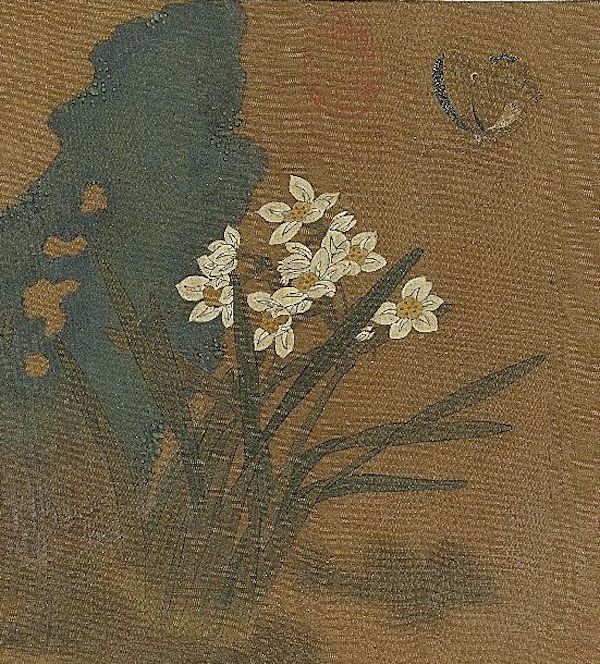
Yuan Wangyuan Painting Flower Book Narcissus Taipei National Palace Museum Collection
Ming Qiuying Narcissus Wintersweet Axis

Ming Qiuying Narcissus Wintersweet Axis Collection of the National Palace Museum, Taipei
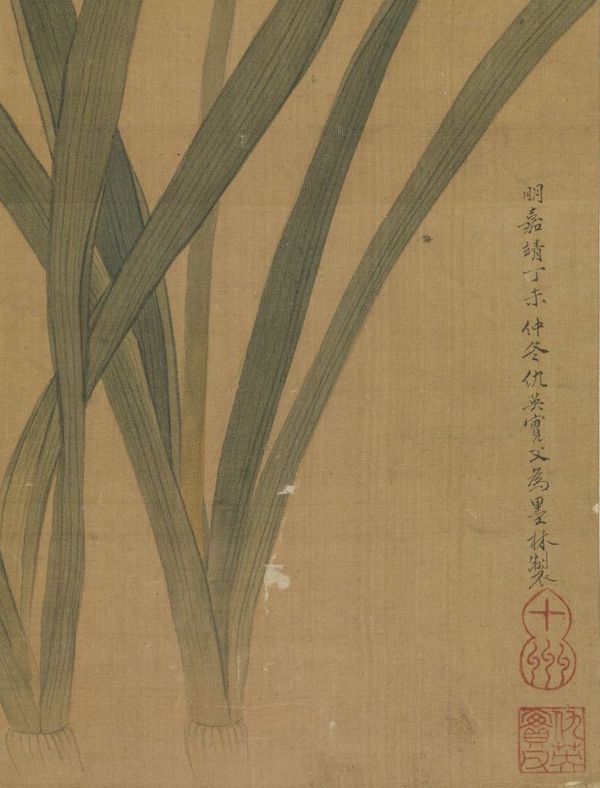
Ming Qiuying Narcissus Wintersweet Axis (Part) Collection of National Palace Museum, Taipei
Qiu Ying, courtesy name Shifu, nickname Shizhou, was born in Taicang, Jiangsu Province. There is no record in the history of the New Year pictures of his birth and death, but it is estimated from the surviving and inscribed works that he was active from the fourth year of Emperor Wuzong Zhengde (1509) to the 31st year of Emperor Jiajing's reign (1552) for more than forty years. Legend has it that he worked as a painter in his early years and was met by the painter Zhou Chen. He was amazed at his talent, so he took the initiative to take him in and teach him painting. Later, he became famous after copying ancient paintings. His works, regardless of landscapes, figures, ladies and gentlemen, bamboo, stone and flowers, are all exquisite in brushstrokes and bright in color, but they can take off the craftsmanship, giving people a feeling of elegance, beauty, craftsmanship and not vulgarity.
Ming Chen Hongshou Narcissus Bamboo and Stone Fan Page

Ming Dynasty Chen Hongshou Narcissus Bamboo and Stone Fan Page Collection of the Palace Museum
The fan page has its own title: "Gengyin Mengdong, Zhang Zhanlao, Jingsi Laoguo and Jingsi Laoguo Gongzhi Daoyou Tianxiang Mansion, painted this in the wine fight meeting, and got this good in fighting. Hong Shou." Seal "Zhanghou" Zhu Wen print. "Geng Yin" is the seventh year of Shunzhi in Qing Dynasty (1650), when Chen Hongshou was 53 years old.
It draws a small garden scene accompanied by narcissus, green bamboo and rocks. The stone is lined and rubbed with a side edge, and the brushwork is vigorous, showing the hard texture of the stone, and bringing out the delicate beauty of narcissus and bamboo. According to the title, this picture was drawn by the author and his friends while they were drunk. Since the author's freehand flower technique has reached the point of proficiency in his later years, from the composition of the picture to the application of brush and ink, it is done in one go, obeying the rules and not messy.
Ming Xu Wei Sketchbook Ink Painting Narcissus

Ming Xu Wei's Sketchbook Ink and Wash Painting Narcissus in the National Palace Museum, Taipei
Narcissus scroll painted by Zhang Yuanshi in Ming Dynasty
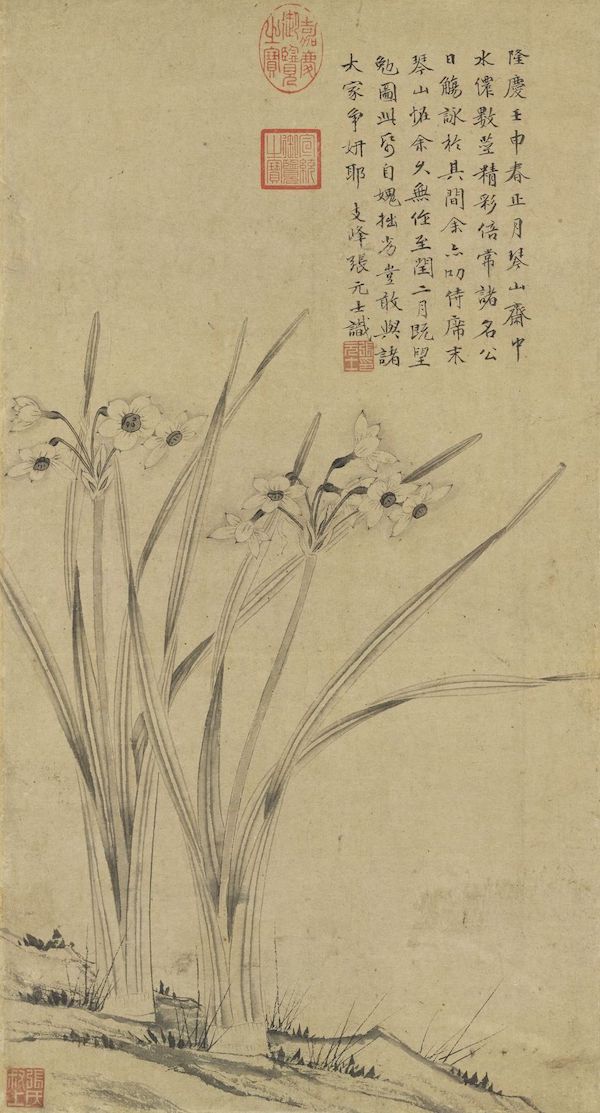
Narcissus scroll painted by Zhang Yuanshi, Ming Dynasty, National Palace Museum, Taipei
Zhang Yuanshi, his deeds during the year are to be tested. Zhang Yuanshi's name is signed in Zhifeng, and Zhang's uncle is printed on the bottom of the painting. It seems that Shushang is Yuanshi's character, and Zhifeng is either a place name or another signature. His brush and ink are so elegant, and the narcissus has the legacy of Zhao Zigu, but the painting biography does not contain his surname, so it can be said that there are leftovers in the wild. This painting was made in Renshen, Longqing, and there is a long postscript on it. The calligraphy is quite similar to that of Wen Xiucheng.
Ming Chen Chun's Sketchbook
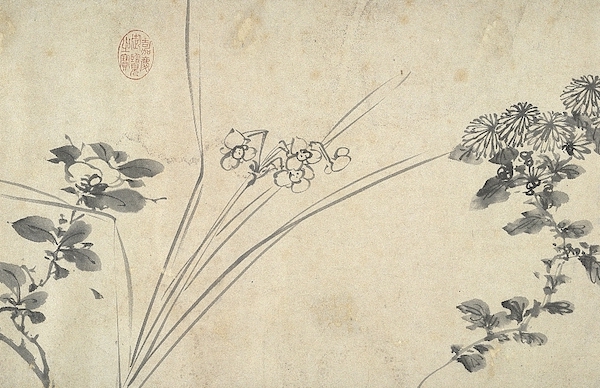
Ming Dynasty Chen Chun Sketch Scroll (Partial) Collection of National Palace Museum, Taipei
Chen Chun (1483─1544), a native of Changzhou (Suzhou, Jiangsu). His real name was Chun, and his style name was Daofu. Later, he changed his style to Xing, and then changed his style to Fufu. He was nicknamed Baiyangshanren. Naturally enlightened, talented with beautiful hair, once studied under Wen Zhengming's school, Zhengming only modestly called him his career teacher, but did not dare to call himself a calligrapher and painter. Chen Chun specializes in flowers and intensively studies ink painting techniques. His brushwork is simple and full of meaning. His predecessors criticized him as "a flower and a half leaf, light ink and boldness, sparse and oblique, chaotic, aggressive and realistic", and he is the master of ink freehand brushwork painters in later generations. The peony in the painting is front-facing, and the ink and wash are thick and light. Although no color is used, it has a colorful and bright feeling.
Ming Sunzhi Plum Blossom Narcissus Axis

Ming Sunzhi Plum Blossom Narcissus Axis Collection of the National Palace Museum, Taipei
Sun Zhi (active between 1535-1601), a native of Wu County, Jiangsu. The name is Shuda, and the name is Hualin Jushi. The style of painting originated from Wen Zhengming (1470-1559). Whether it is landscapes, figures, or flowers, they all have a strong literary style.
This painting was made in the winter of the thirty-eighth year of Jiajing (1559). It is a panoramic composition method, with slopes, rocks, flowers and trees, all of which should be complete, forming a picture with front and rear depth and a sense of space. The branches of the plum tree are drawn in light ink, the petals are circled with a fine brush, and the calyx and stamens are dotted with thick ink. The ink-dyed lake stones are interspersed between the two, bringing the contrast between the virtual and the real, giving people a sense of cleanliness, freshness and elegance.
Scroll of flowers painted by Sun Kehong of Ming Dynasty

Scroll of flowers painted by Sun Kehong of the Ming Dynasty (partial) Collection of the National Palace Museum, Taipei
Sun Kehong (1533-1611), also known as Kehong, was born in Huating, Jiangsu. The word is Yunzhi, and the name is Xueju. He was born in the 12th year of Emperor Sejong's Jiajing reign and died in the 39th year of Shenzong's Wanli reign. He studied calligraphy and painting diligently all his life. He is both talented and hardworking. For the ancients, he learned from Ma Yuan, Yunshan from Mi Fu, flowers and birds from Xu Xi and Zhao Chang, ink, bamboo and stone from Wentong, and bluegrass from Zheng Sixiao. , Buddhist and Taoist figures learned from Liang Kai, and they all made great achievements. In his later years, he lived in seclusion in Dongguo Thatched Cottage, and devoted himself to painting plums. Sun has the foundation of being close to ancient times, and then uses the brush to sketch, so the image is as natural as it is, and has the charm of brush and ink.
Axis of Ming Lu Zhi Qun Xian Gong Shou Tu

Ming Luzhi Qunxian Gongshou Picture Axis Taipei National Palace Museum Collection

Ming Lu Zhi Qun Xian Gong Shou Tu Axis (partial) Taipei National Palace Museum Collection
Ming Luzhi sketch book ink and color Narcissus
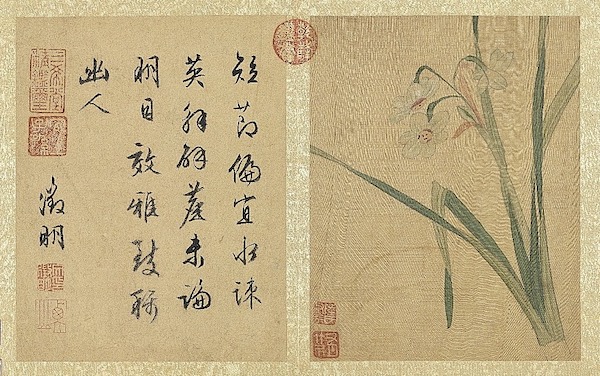
Ming Luzhi Sketchbook Ink and Color Narcissus Collection of the National Palace Museum, Taipei
Ming Ma Shouzhen painting album line drawing narcissus
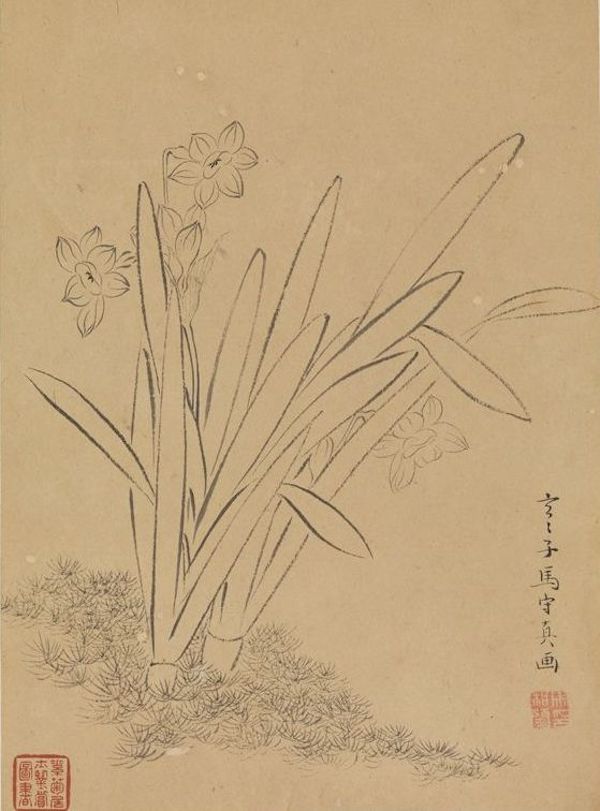
Ming Ma Shouzhen Album Line Drawing Narcissus Collection of the National Palace Museum, Taipei
Qing Yun Shouping imitation of ancient book Narcissus
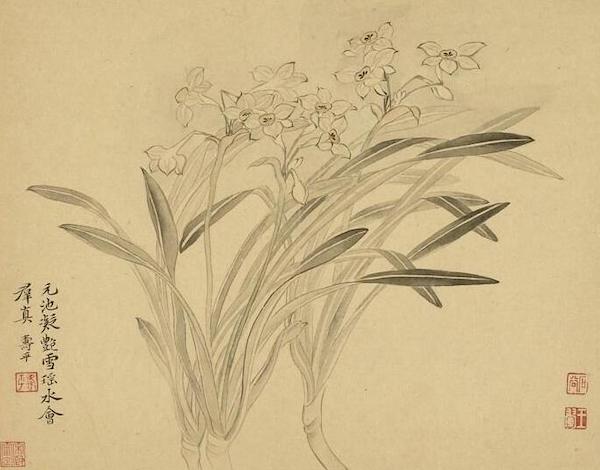
Qing Yun Shouping Copy Ancient Book Narcissus Collection of National Palace Museum, Taipei
Yun Shouping (1633-1690), originally named Ge, styled Shouping, later changed to style, was born in Wujin, Jiangsu. He was good at painting landscapes at first, but because of self-effacement and unable to compete with Wang Hui (1632-1717), he switched to flowers. The style is soft and elegant, and he is the master of flower painting in the Qing Dynasty. This painting is selected from "Imitation of Ancient Books". Three narcissus are drawn with white ink lines, the turning points are dyed light and dark with light ink, the core is slightly dyed with gamboge, and the periphery of the petals is faintly colored with blue. Although the color is light, the swaying flowers and leaves seem to smell a delicate fragrance. During the cold and windy January and February, the daffodils are beautiful in shape and have a unique fragrance. They are suitable for the Spring Festival and add auspicious atmosphere.
(This article is compiled from relevant materials of the Palace Museum and Taipei Palace Museum.)
